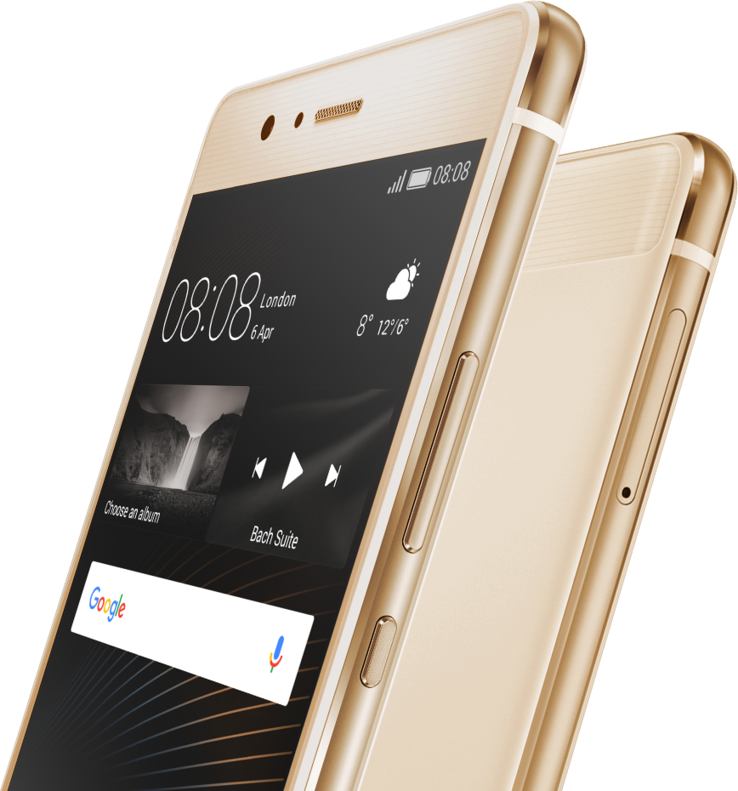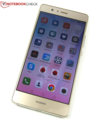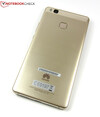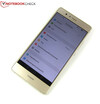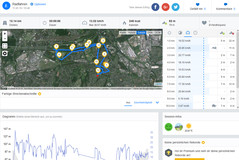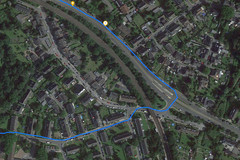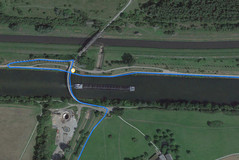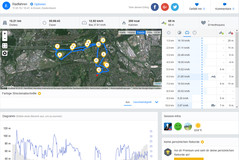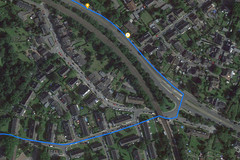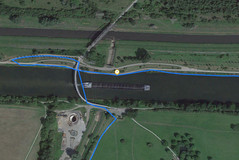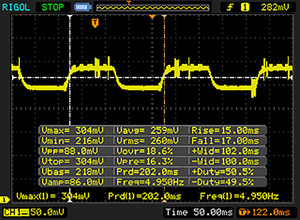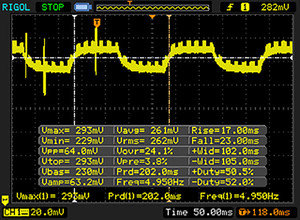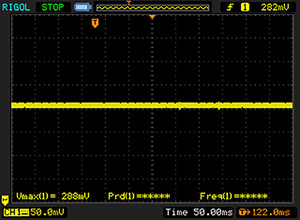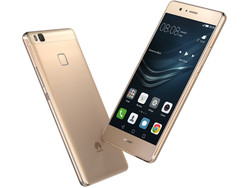Breve Análise do Smartphone Huawei P9 Lite
Os Top 10
» Os Top 10 Portáteis Multimídia
» Os Top 10 Portáteis de Jogos
» Os Top 10 Portáteis Leves para Jogos
» Os Top 10 Portáteis Acessíveis de Escritório/Empresariais
» Os Top 10 Portáteis Premium de Escritório/Empresariais
» Os Top 10 dos Portáteis Workstation
» Os Top 10 Subportáteis
» Os Top 10 Ultrabooks
» Os Top 10 Conversíveis
» Os Top 10 Tablets
» Os Top 10 Smartphones
» A melhores Telas de Portáteis Analisadas Pela Notebookcheck
» Top 10 dos portáteis abaixo dos 500 Euros da Notebookcheck
» Top 10 dos Portáteis abaixo dos 300 Euros
| |||||||||||||||||||||||||
iluminação: 88 %
iluminação com acumulador: 505 cd/m²
Contraste: 682:1 (Preto: 0.74 cd/m²)
ΔE ColorChecker Calman: 4.1 | ∀{0.5-29.43 Ø4.77}
ΔE Greyscale Calman: 4.9 | ∀{0.09-98 Ø5}
Gamma: 2.5
CCT: 7116 K
| Huawei P9 Lite Mali-T830 MP2, Kirin 650, 16 GB eMMC Flash | Asus ZenFone Selfie ZD551KL Adreno 405, 615 MSM8939, 32 GB eMMC Flash | Honor 5X Adreno 405, 616 MSM8939v2, 16 GB eMMC Flash | Huawei P8 lite Mali-450 MP4, Kirin 620, 16 GB eMMC Flash | Huawei P9 Mali-T880 MP4, Kirin 955, 32 GB eMMC Flash | Samsung Galaxy J5 2016 Adreno 306, 410 MSM8916, 16 GB eMMC Flash | Samsung Galaxy A3 2016 Mali-T720 MP2, 7578, 16 GB eMMC Flash | |
|---|---|---|---|---|---|---|---|
| Screen | 3% | 8% | -3% | 22% | -12% | 25% | |
| Brightness middle (cd/m²) | 505 | 392 -22% | 535 6% | 365 -28% | 582 15% | 289 -43% | 386 -24% |
| Brightness (cd/m²) | 468 | 382 -18% | 521 11% | 353 -25% | 563 20% | 291 -38% | 394 -16% |
| Brightness Distribution (%) | 88 | 93 6% | 85 -3% | 93 6% | 91 3% | 96 9% | 88 0% |
| Black Level * (cd/m²) | 0.74 | 0.41 45% | 0.43 42% | 0.42 43% | 0.38 49% | ||
| Contrast (:1) | 682 | 956 40% | 1244 82% | 869 27% | 1532 125% | ||
| Colorchecker dE 2000 * | 4.1 | 5.55 -35% | 4.88 -19% | 5.2 -27% | 4.4 -7% | 4.7 -15% | 1.11 73% |
| Colorchecker dE 2000 max. * | 5.8 | 8.66 -49% | 7.4 -28% | 7.3 -26% | 3.35 42% | ||
| Greyscale dE 2000 * | 4.9 | 4.7 4% | 5.2 -6% | 5.85 -19% | 4.8 2% | 3 39% | 1.34 73% |
| Gamma | 2.5 88% | 2.7 81% | 2.26 97% | 2.17 101% | 2.2 100% | 2.03 108% | 2.12 104% |
| CCT | 7116 91% | 7270 89% | 7766 84% | 7252 90% | 6175 105% | 6291 103% | 6441 101% |
| Color Space (Percent of AdobeRGB 1998) (%) | 70.86 | 77.78 | |||||
| Color Space (Percent of sRGB) (%) | 91.25 | 99.44 |
* ... menor é melhor
Exibir tempos de resposta
| ↔ Tempo de resposta preto para branco | ||
|---|---|---|
| 32 ms ... ascensão ↗ e queda ↘ combinadas | ↗ 15 ms ascensão | |
| ↘ 17 ms queda | ||
| A tela mostra taxas de resposta lentas em nossos testes e será insatisfatória para os jogadores. Em comparação, todos os dispositivos testados variam de 0.1 (mínimo) a 240 (máximo) ms. » 85 % de todos os dispositivos são melhores. Isso significa que o tempo de resposta medido é pior que a média de todos os dispositivos testados (20.2 ms). | ||
| ↔ Tempo de resposta 50% cinza a 80% cinza | ||
| 40 ms ... ascensão ↗ e queda ↘ combinadas | ↗ 17 ms ascensão | |
| ↘ 23 ms queda | ||
| A tela mostra taxas de resposta lentas em nossos testes e será insatisfatória para os jogadores. Em comparação, todos os dispositivos testados variam de 0.165 (mínimo) a 636 (máximo) ms. » 60 % de todos os dispositivos são melhores. Isso significa que o tempo de resposta medido é pior que a média de todos os dispositivos testados (31.6 ms). | ||
Cintilação da tela / PWM (modulação por largura de pulso)
| Tela tremeluzindo / PWM não detectado | |||
[pwm_comparison] Em comparação: 53 % de todos os dispositivos testados não usam PWM para escurecer a tela. Se PWM foi detectado, uma média de 8083 (mínimo: 5 - máximo: 343500) Hz foi medida. | |||
| AnTuTu v6 - Total Score (classificar por valor) | |
| Huawei P9 Lite | |
| Honor 5X | |
| Huawei P9 | |
| Samsung Galaxy J5 2016 | |
| Samsung Galaxy A3 2016 | |
| Geekbench 3 | |
| 64 Bit Single-Core Score (classificar por valor) | |
| Huawei P9 Lite | |
| Asus ZenFone Selfie ZD551KL | |
| Honor 5X | |
| Huawei P8 lite | |
| Huawei P9 | |
| Samsung Galaxy J5 2016 | |
| 64 Bit Multi-Core Score (classificar por valor) | |
| Huawei P9 Lite | |
| Asus ZenFone Selfie ZD551KL | |
| Honor 5X | |
| Huawei P8 lite | |
| Huawei P9 | |
| Samsung Galaxy J5 2016 | |
| GFXBench (DX / GLBenchmark) 2.7 | |
| T-Rex Onscreen (classificar por valor) | |
| Huawei P9 Lite | |
| Asus ZenFone Selfie ZD551KL | |
| Honor 5X | |
| Huawei P8 lite | |
| Huawei P9 | |
| Samsung Galaxy J5 2016 | |
| Samsung Galaxy A3 2016 | |
| 1920x1080 T-Rex Offscreen (classificar por valor) | |
| Huawei P9 Lite | |
| Asus ZenFone Selfie ZD551KL | |
| Honor 5X | |
| Huawei P8 lite | |
| Huawei P9 | |
| Samsung Galaxy J5 2016 | |
| Samsung Galaxy A3 2016 | |
| GFXBench 3.0 | |
| on screen Manhattan Onscreen OGL (classificar por valor) | |
| Huawei P9 Lite | |
| Asus ZenFone Selfie ZD551KL | |
| Honor 5X | |
| Huawei P9 | |
| Samsung Galaxy J5 2016 | |
| Samsung Galaxy A3 2016 | |
| 1920x1080 1080p Manhattan Offscreen (classificar por valor) | |
| Huawei P9 Lite | |
| Asus ZenFone Selfie ZD551KL | |
| Honor 5X | |
| Huawei P9 | |
| Samsung Galaxy J5 2016 | |
| Samsung Galaxy A3 2016 | |
| GFXBench 3.1 | |
| on screen Manhattan ES 3.1 Onscreen (classificar por valor) | |
| Huawei P9 Lite | |
| Huawei P9 | |
| Samsung Galaxy J5 2016 | |
| 1920x1080 Manhattan ES 3.1 Offscreen (classificar por valor) | |
| Huawei P9 Lite | |
| Huawei P9 | |
| Samsung Galaxy J5 2016 | |
| PCMark for Android - Work performance score (classificar por valor) | |
| Huawei P9 Lite | |
| Asus ZenFone Selfie ZD551KL | |
| Honor 5X | |
| Huawei P8 lite | |
| Huawei P9 | |
| Samsung Galaxy J5 2016 | |
| Samsung Galaxy A3 2016 | |
| Octane V2 - Total Score (classificar por valor) | |
| Huawei P9 Lite | |
| Asus ZenFone Selfie ZD551KL | |
| Honor 5X | |
| Huawei P8 lite | |
| Huawei P9 | |
| Samsung Galaxy J5 2016 | |
| Samsung Galaxy A3 2016 | |
| Mozilla Kraken 1.1 - Total (classificar por valor) | |
| Huawei P9 Lite | |
| Asus ZenFone Selfie ZD551KL | |
| Honor 5X | |
| Huawei P8 lite | |
| Huawei P9 | |
| Samsung Galaxy J5 2016 | |
| Samsung Galaxy A3 2016 | |
| JetStream 1.1 - Total Score (classificar por valor) | |
| Huawei P9 Lite | |
| Asus ZenFone Selfie ZD551KL | |
| Honor 5X | |
| Huawei P9 | |
| Samsung Galaxy J5 2016 | |
| Samsung Galaxy A3 2016 | |
* ... menor é melhor
| Asphalt 8: Airborne | |||
| Configurações | Valor | ||
| high | 30 fps | ||
| Dead Trigger 2 | |||
| Configurações | Valor | ||
| high | 60 fps | ||
(±) A temperatura máxima no lado superior é 42.1 °C / 108 F, em comparação com a média de 35.2 °C / 95 F , variando de 21.9 a 247 °C para a classe Smartphone.
(+) A parte inferior aquece até um máximo de 36 °C / 97 F, em comparação com a média de 34 °C / 93 F
(±) Em uso inativo, a temperatura média para o lado superior é 33.6 °C / 92 F, em comparação com a média do dispositivo de 32.9 °C / ### class_avg_f### F.
| desligado | |
| Ocioso | |
| Carga |
|
Key:
min: | |
| Huawei P9 Lite Mali-T830 MP2, Kirin 650, 16 GB eMMC Flash | Asus ZenFone Selfie ZD551KL Adreno 405, 615 MSM8939, 32 GB eMMC Flash | Honor 5X Adreno 405, 616 MSM8939v2, 16 GB eMMC Flash | Huawei P8 lite Mali-450 MP4, Kirin 620, 16 GB eMMC Flash | Huawei P9 Mali-T880 MP4, Kirin 955, 32 GB eMMC Flash | Samsung Galaxy J5 2016 Adreno 306, 410 MSM8916, 16 GB eMMC Flash | Samsung Galaxy A3 2016 Mali-T720 MP2, 7578, 16 GB eMMC Flash | |
|---|---|---|---|---|---|---|---|
| Duração da bateria | -10% | -15% | -39% | -6% | 21% | 34% | |
| Reader / Idle (h) | 23.4 | 16.8 -28% | 17.6 -25% | 11.9 -49% | 25.2 8% | 26.7 14% | 33 41% |
| H.264 (h) | 9.5 | 8.8 -7% | 10 5% | 6.2 -35% | 9.5 0% | 11 16% | 14.4 52% |
| WiFi v1.3 (h) | 10.1 | 8.6 -15% | 10.7 6% | 5.9 -42% | 9.5 -6% | 10.7 6% | 10.5 4% |
| Load (h) | 4.5 | 4.9 9% | 2.4 -47% | 3.2 -29% | 3.4 -24% | 6.7 49% | 6.3 40% |
Pro
Contra
Com o P9 Lite, a Huawei tem um potente smartphone de gama média em sua linha, que faz muitas coisas melhor que o anterior P8 Lite. Não é um verdadeiro oponente para o carro chefe Huawei P9 que oferece o leitor de digitais superior, LTE mais veloz, Bluetooth mais recente, Wi-Fi dual-band, USB Type-C, um SoC muito mais veloz e um painel de maior contraste. Ambos os smartphones virtualmente tem o mesmo visual, embora a mistura de metal-plástico do P9 Lite não deixa uma impressão de alta qualidade quanto a do corpo monobloco de alumínio do P9. No entanto, não queremos falar mal do P9 Lite: O irmão menor do P9 atrai com o seu painel Full HD muito brilhante e o SO Android 6.0.1 mais recente. Um veloz SoC HiSilicon Kirin 650 e 3 GB de memória de trabalho também participam e garantem uma boa velocidade de trabalho. A conectividade não dá motivo para reclamar com LTE, Wi-Fi 802.11n e slot dual-SIM. A muito boa duração da bateria completa o pacote.
A Huawei cria um forte rival para o seu próprio P9, muito mais caro, com o P9 Lite.
O sólido P9 Lite da Huawei apenas tem que aceitar alguns pontos de crítica. A traseira de plástico poderia fornecer mais aderência e a câmera poderia oferecer um pouco mais de qualidade. No entanto, isso é reclamar em um nível alto, vendo que o smartphone já faz boas fotos e vídeos. O mesmo acontece com o painel calibrado de forma inexata, porém, isto dificilmente é notado no uso do dia a dia. O alto falante mono, de fato não deveria estar no lado negativo, dado que também está instalado no P9.
Esta é uma versão reduzida da análise original. Você pode ler a análise completa em inglês aqui.
Huawei P9 Lite
- 05/23/2016 v5.1 (old)
Manuel Masiero


